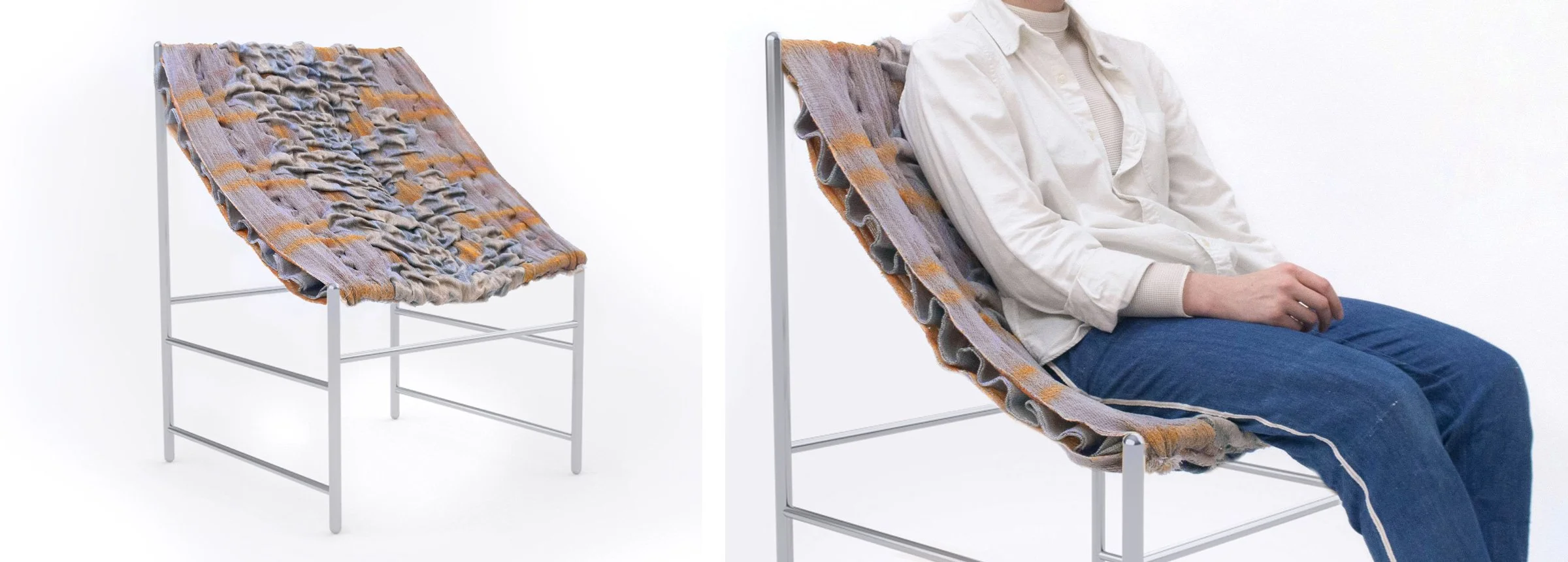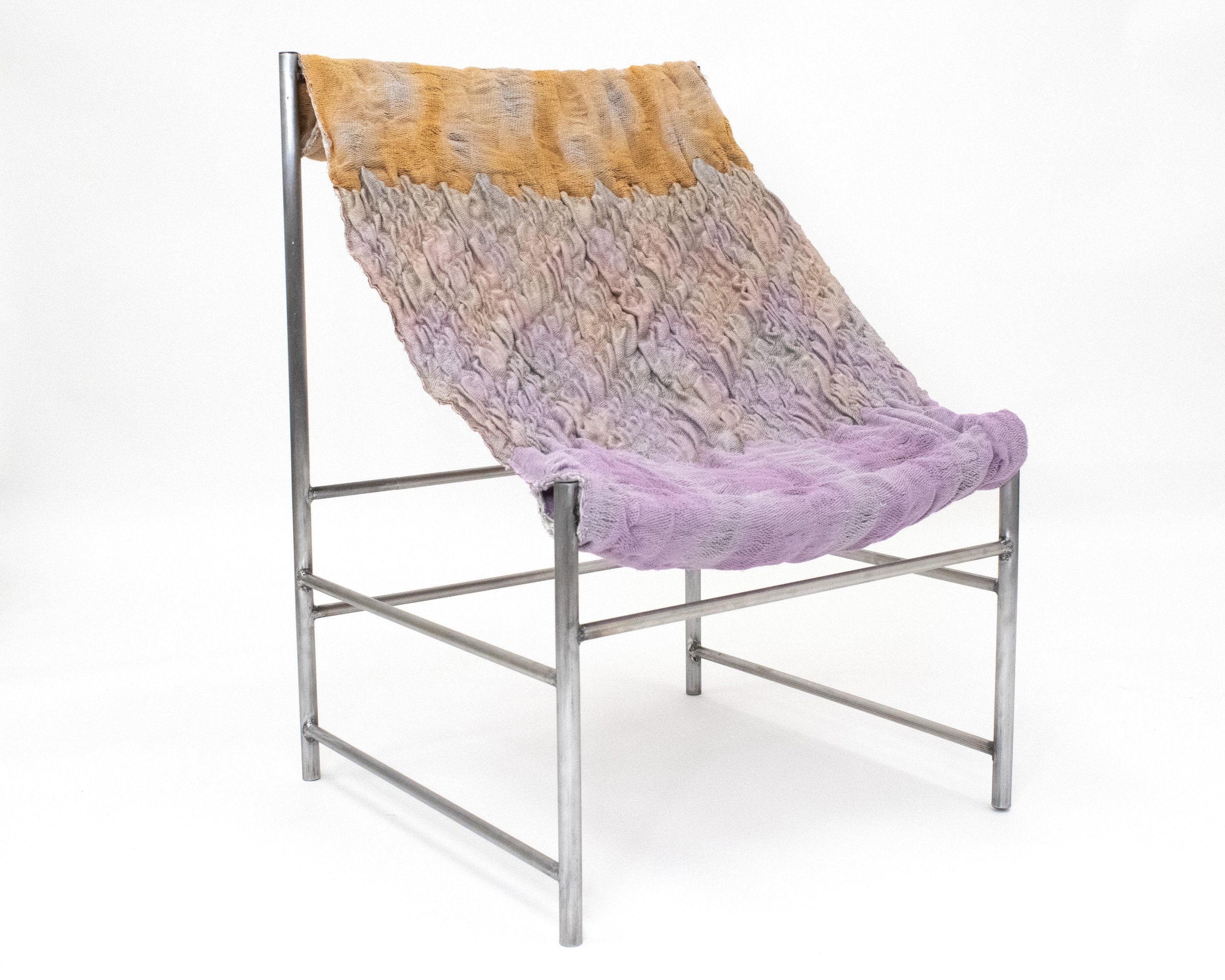Leveraging deep material expertise, VTRG explores a variety of challenges for mechanical and appearance-based textile simulation.
Phases of Transition: Imbuing Textiles with Different Scales of Experience using Digital Materials and Finishing Techniques
The collection of textiles developed in this research project started from initial data captured using the HP Z Captis digital material capture system and subsequent manipulation in Adobe Substance to highlight specific experiential qualities and overlooked processes in the source fabrics at various observation scales. These digital results became instructive assets for developing new physical textiles through bespoke fabric manipulation techniques, enhancing typically hidden textile properties ranging from the source fiber to emotive sensations. Exploring textural, structural, and optical properties with procedural texturing, the resulting digital transformations highlighted technical processes typically flattened or embedded within textiles, along with spatial conditions, light interactions, touch responses, and patterns of wear. Distilling into scalable outputs, these transformations reveal latent material properties and establish new reference points for textile materiality and transferable experiential substances.
Collection exhibited at Future of Tradition, Jaipur Edition, Jan 2025
Presentation at SCALES conference, Aalto University, April 2025
Image Courtesy of A. Soiseth, Surface Tear
Materiality in Motion: Sensing the Tactility of Virtual Textiles through Movement
The material qualities of fabrics engage all of the senses. Exposure to these multisensory traits—primarily visual and haptic—enables an understanding of textile behavior and possibilities. Static images often limit our interpretation of a textile’s essence, while touching reveals its complexity. Pandemic-era digital interactions have challenged our connection to materiality—screen-based experiences are increasingly common, yet fabrics often lose much of their affective potential when rendered digitally. Within this paradigm we explore material experiences in virtual space, using movement to heighten the sensory qualities of digital materials. With an eye toward techniques prioritizing faithful capture and re-creation, or embracing glitch in the process of digitizing the physical, we've analyzed three case studies in which highly tactile fabrics are represented as virtual artifacts, immersive landscapes, and parameterized materials alive with motion.
Paper, D_TEX, 2024, “Textiles, Identity and Innovation“
PDF
Feeling Fabrics: Prototyping Sensory Experiences with Textiles and Digital Materials
The experiential qualities of materials play an important role in how designed products are used, appreciated and understood. Materials with pronounced visual, auditory or haptic behaviors and temporal forms can lead to engaging, multisensory interactions. However, many designers, including textile designers, currently lack tools for directly shaping these end-user experiences at the sensory level, and for understanding material experience at an early prototyping stage. With a focus on the design of dimensional, shape-changing and otherwise structurally complex textiles, we present a set of design practices and a case study in building a collection of novel materials with highly specific sensory qualities that exist both digitally and physically. Two key additions to the typical textile design workflow presented in this paper are our use of the "generalized swatch", an initial prototype that prioritizes precise multisensory description; and our usage of procedural material design software to visualize these prototypes as digital materials that can convey sensory, tactile and temporal qualities.
Paper, EKSIG, 2023.
Proceedings | PDF
Woven Behavior and Ornamentation: Simulation-Assisted Design and Application of Self-Shaping Woven Textiles
The class of self-shaping woven textiles are those that undergo a transformation in shape exhibiting three-dimensional behaviors due to the interplay between weave structure and active yarns that shrink, twist or otherwise move during finishing processes such as steaming. While weaving with active yarns to produce dimensional fabrics has existed for millennia, the unpredictability of the complex interactions involved, even for industrial weaving, typically necessitates arduous physical sampling for intentional design and use. Current weaving software, overwhelmingly reliant on 2D graphic depiction of woven fabric, is wholly unable to provide the predictive dimensional appearance of such fabrics that might lead to practical decision making and innovative design solutions. This paper describes an iterative workflow to design self-shaping woven fabrics, from simulation-assisted drafting to the creation of a library of woven behaviors categorized by attributes for seating design. This workflow is then used to inform the design of a new yarn-based simulator as well as to design and fabricate a textile-centric furniture piece in which these woven fabric behaviors and ornamentation are intentionally zoned to the form according to structural, ergonomic and aesthetic considerations.
Rapid Sketching of Woven Textile Behavior
Woven textiles are typically designed with methods and software that demonstrate the graphical aspects of fabric but are limited in their representation of fabric behavior. The category of textiles that undergo shape changes in the finishing phase are well suited to alternate design approaches that incorporate predictive modeling. In this paper, we describe a methodology that uses parametric modeling and simulation to ideate, refine and inform physically produced woven fabrics with specific dimensional qualities, shifting the iterative work inherent to textile design into a digital space.
Automatic Structure Synthesis for 3D Woven Relief
3D weaving is a manufacturing technique that creates multilayer textiles with substantial thickness. Currently, the primary use for these materials is in regularly structured carbon-polymer or glass-polymer composites, but in principle a wide range of complex shapes can be achieved, providing the opportunity to customize the fiber structure for individual parts and also making 3D weaving appealing in many soft-goods applications. The primary obstacle to broader use is the need to design intricate weave structures, involving tens to hundreds of thousands of yarn crossings, which are different for every shape to be produced. The goal of this research is to make 3D weaving as readily usable as CNC machining or 3D printing, by providing an algorithm to convert an arbitrary 3D solid model into machine instructions to weave the corresponding shape. We propose a method to generate 3D weaving patterns for height fields by slicing the shape along intersecting arrays of parallel planes and then computing the paths for all the warp and weft yarns, which travel in these planes.
Weavecraft: An Interactive Simulation and Design Tool for 3D Weavers
This work presents Weavecraft: an interactive, simulation-based design tool for 3D weaving, an emerging technology for manufacturing multilayer woven textiles. Unlike existing textile software that uses 2D representation for design patterns, we propose a novel weave block representation that helps the user to understand 3D woven structures and to create complex multi-layered patterns. With Weavecraft, users can create blocks either from scratch or by loading traditional weaves, compose the blocks into large structures, and edit the pattern at various scales. Furthermore, users can verify the design with a physically based simulator, which predicts and visualizes the geometric structure of the woven material and reveals potential defects at an interactive rate. We demonstrate a range of results created with our tool, from simple two-layer cloth and well known 3D structures to a more sophisticated design of a 3D woven shoe, and we evaluate the effectiveness of our system via a formative user study.
Technical Paper, SIGGRAPH ASIA, 2020;
DOI | PDF
Weaving Objects: Spatial Design and Functionality of 3D Woven Textiles
3D woven ares typically used for ultra-strong and lightweight composites such as engine fan blades and ballistic armor. These fabrics are difficult to engineer and can involve up to 40+ layers of material. The extreme depth of the fabrics means that yarns often travel on a “Z” axis as they move from one layer to another. Predicting yarn-based changes involving compression, friction and take-up is key to the successful composition of a sample, and CAD systems currently on the market do not robustly address these concerns.
Through partnership with Rhode Island manufacturer, TEAM, Inc, we have accessed industrial weaving equipment to develop a range of samples exploring various parameters and properties of 3D woven textiles. This information is passed to the researchers at Cornell, who are working on a UI that divides complex 3D fabrics into small and easy to understand component parts, the various configurations of which demonstrate allowable interactions and connections between multiple layers of a textile. Once a selection is made, the system utilizes offline relaxation to demonstrate the behavior of yarns and structures in the selected configuration, creating an end model that accurately shows behavioral dynamics and provides feedback about physical fabric behavior and allowable design/engineering decisions.
Looking Back to Look Forward: Reanimating Textiles for Novel Design and Manufacturing
Industrially produced textile samples woven in France during the 19th and early 20th centuries were shipped around the world and had a significant influence on the types of fabrics produced in the US textile market and elsewhere. These fabrics were capsules of fashion and timeliness, suggesting ideas about color, scale, graphics and surface to the broader industry, and providing new material for interior and apparel application.
In this project we look at woven textile samples from the RISD Museum Costume & Textile Collection with a focus upon Jacquard figured leno weaving and varied-height looped and cut pile techniques. The leno process relies upon an added harness element called a doup-heddle which functions as a parallel, programmable loom language in tandem with the Jacquard mechanism. The pile process calls for a unique set of hand tools and procedures to achieve variation in height and directionality of the pile.
Utilizing a computerized tomography (CT) scanning process, we are able to demonstrate the behavior of the yarns and the sequencing of the action within each sample. We then set up looms to create new samples informed by the old constructions, resulting in novel tools that draw upon rapid prototyping and complex computational modeling to reanimate these industrial techniques as viable strategies for the production of contemporary fabrics.
Paper, Futurescan4: Valuing Practice, January 2019; Discussion, Repair and Design Futures, March 2019; Paper, Journal of Textile Design Research and Practice, 2020.
DOI | PDF
Broad and Deep: Design Process and Visualization of Multi-Vector Wovens
Most dimensional weaving executed on rapier or shuttle looms requires sequential line-by-line weft insertion and sequential shed formation. The recent development of multi-shuttle looms and servo-driven shedding systems changes this— now, it is possible to activate multiple shuttles simultaneously, and build the depth of a fabric exponentially on a single “line”. The servo shedding system allows for varied shed height control so that different weave structures can advance at different rates on the various layers of the fabric, while shuttle action (rather than rapier or air-jet ) allows for partial passage turnaround and the creation of channels, conduits, and negative space on different layers of a cloth, all simultaneously rather than sequentially.
With limited access to such equipment, the VTRG has developed a hand-based process that relies upon a multi-harness loom, a creel, a jig system for simultaneous sheds, and a narrow shuttle insertion system in order to create a rough equivalent for developing examples of “quantum” woven fabrics. This process has allowed us to formulate an approach to the various design factors, which in turn informs the development of a UI and how one might design these fabrics computationally in a fully industrial environment.
Paper, D_TEX 2019; Chapter, Textiles, Identity, and Innovation: In Touch, 2020.
DOI | PDF












